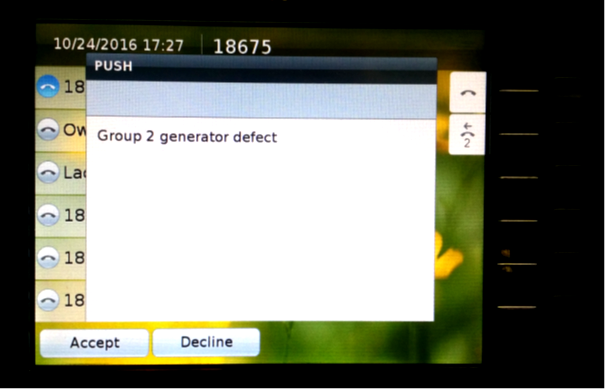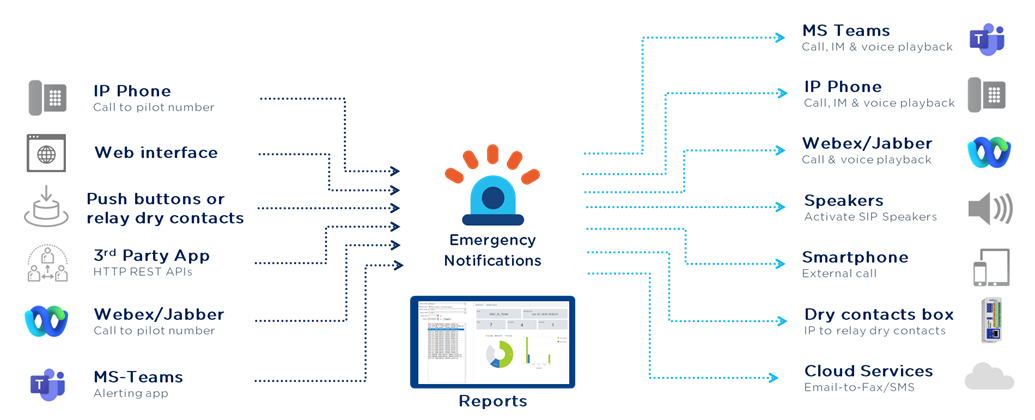Imagicle EN Voice Alerts
Voice Alerts is an alert management application for Cisco Unified Communication Manager. Its web interface is available in French and English.
Voice Alert may be used to automatically alert a list of internal or external recipients and playback a recorded audio message alert or send text messages to IP Phones. Voice Alert can also send SMS, emails or Fax and it can playback audio on SIP Speakers. You can also create a conference on-the-fly with all the destinations, to handle crisis management.
Voice Alerts can check that the call/message has been delivered and acknowledged; otherwise repeating the call or escalate.
Voice Alerts includes a dashboard and some reports that can be sent to supervisors.
Usage Samples
Breakdown: When a machine breaks down, it may automatically raise an alert by closing a dry contact. An alert is consequently generated to the maintenance team, either by a text message or a phone call, until one team member accepts and acknowledge it.
Security alert: An Imagicle Engage agent, equipped with its own UCX Agent Console, may raise an alert by hitting the Panic button. The security team is in turns alerted via phone call on their IP phones or mobile phones, with the option of acknowledge the notification.
Evacuation alert: The security agents trigger an alert from a web control panel. All the employees of the building are alerted by a call on their IP Phone or on Microsoft Teams. The audio message is also played back in the corridors by leveraging SIP speakers.
Isolated worker: If a worker faints or falls down, its DECT phone may automatically trigger a call to a Voice Alerts entry point (Man Down DECT feature). This in turns generates an alert to the security teams.
Alert triggering
An authorized user can access to a Web control panel to start, monitor or stop alerts. Alerts can be organized in alert’s groups.
The alert may be triggered by calling a directory number, from an authorized calling number and eventually by typing a DTMF PIN code. The alert is selected according to the dialed number (one pilot per alert), or according to a list of calling numbers.
The alert can also be triggered by a dry contact, such as by pressing a button or a relay contact closure. In this case, a dry contact/IP converter is required (i.e. ControlByWeb devices).
The alert can also be triggered by an external application:
By calling an URL, from an authorized calling IP address.
By adding a text file in a shared folder.
Target lists, distribution modes
The administrator can define different alerts with a specific audio message, text message, recipients list, distribution and cycle modes.
The recipient list can be defined as:
A list of users (with several directory numbers, email, SMS, fax);
A list of directory numbers or Microsoft Teams URIs;
A selection of users from a filtered directory (AD, LDAP, database, text file);
A selection of IP address ranges;
A list of IP Phones;
A selection of Device Pools;
A selection of Locations;
The list is sequentially scanned to mix the different destinations with different selection criteria (for example to avoid calling all building A, then building B).
It is possible to associate two list types: for example, one for internal IP phones and a list of directory numbers for mobile phones.
Different distribution modes are available:
Broadcast: all recipients are simultaneously alerted;
Sequential: the numbers are called in sequential order. When a call is answered and acknowledged, the alert cycle is stopped;
Broadcast on contacts, sequential on directory numbers associated to each contact;
If the dialed recipient is busy, it is possible to force ongoing call drop and play back the alert (CUCM);
Numbers forwarded to external lines are not engaged (CUCM).
The alert can be considered as accepted, when:
The call is answered within a configurable ring time;
The call duration reaches a minimum, configurable length;
The recipient has entered a DTMF acknowledge code;
The text notification is confirmed on IP Phone display (see below sample).

When the call is not answered or not listened for a minimum duration, the call is cycled several times after a defined delay.
An output dry contact relay can be closed, during the duration of the alert or when started or when at least one destination user has acknowledged the call.
Reporting
A report is available from Emergency Notification web portal, to monitor the triggered alerts. It provides information on who has raised the alert, who has been called and who has listened/view/acknowledge the alert. The result of the call for each destination is also displayed, providing status and failure cause.
The Alert report can be exported or sent by email to supervisors’ address list.
A dynamic Dashboard is also available, to display real-time data about ongoing alert cycle.

Architecture
Voice Alerts includes an audio server that can play up to 500 simultaneous audio messages. Imagicle Page Alerts has different limitations, tight to the number of pools of CTI Ports with different Device Pool, Partition and Calling Search Space to be included.

The audio messages are loaded from audio files (.wav) and automatically converted to the right format. It is also possible to enter a text which is converted to audio by an embedded Text to Speech engine supporting different languages.
Fault tolerance
Voice Alerts may function in fault tolerance mode. Voice Alerts supports an automatic reconnection to a backup CTI Manager and CUCM Publisher.
Voice Alert can also be installed on replicated servers with the additional Hot Standby module.
